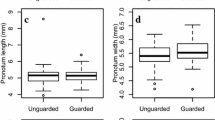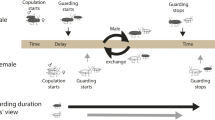Abstract
Birds are commonly sexually promiscuous, which can lead to conflict between the sexes and the evolution of paternity assurance strategies, such as mate guarding. Adaptive explanations for mate guarding have tended to focus on fitness consequences for males, but mate guarding and participation in being guarded is also likely adaptive for females in certain contexts. To better understand the adaptive explanations for mate guarding as well as the observed variation in paternity patterns, it is necessary to explore the relative costs and benefits of guarding (and being guarded) from both the male and female perspective. To investigate these costs and benefits, we conducted an experiment with the Australian zebra finch (Teniopygia guttata) in which we independently varied the perceived opportunity for each member of a captive breeding pair to engage in extra-pair copulation (EPC) solicitation behavior; as an individual’s EPC opportunity increased, the partner’s EPC opportunity remained constant. Our results indicate that, for males, mate guarding intensity increases when their female’s EPC opportunity increases but decreases when their own (i.e., male) EPC opportunity increases. We did not find evidence of flexible female guarding behavior, but we found that females do not evade their partners more as female EPC opportunity increases.




Similar content being viewed by others
References
Alatalo RV, Gottlander K, Lundberg A (1987) Extra-pair copulations and mate guarding in the polyterritorial pied flycatcher, Ficedula hypoleuca. Behaviour 101:139–155
Bennett PM, Owens IPF (2002) Evolutionary ecology of birds: life history, mating systems, and extinction. Oxford University Press, Oxford
Birkhead TR, Møller AP (1992) Sperm competition in birds: evolutionary causes and consequences. Academic, London
Birkhead TR, Clarkson K, Zann R (1988) Extra-pair courtship, copulation, and mate guarding in wild zebra finches Taeniopygia guttata. Anim Behav 36:1853–1855
Birkhead TR, Hunter FM, Pellatt JE (1989) Sperm competition in the zebra finch, Taeniopygia guttata. Anim Behav 38:935–950
Burley NT, Enstrom DA, Chitwood L (1994) Extra-pair relations in zebra finches—differential male success results from female tactics. Anim Behav 48:1031–1041
Burley NT, Parker PG, Lundy K (1996) Sexual selection and extrapair fertilization in a socially monogamous passerine, the zebra finch (Taeniopygia guttata). Behav Ecol 7:218–226
Chuang-Dobbs HC, Webster MS, Holmes RT (2001) The effectiveness of mate guarding by male black-throated blue warblers. Behav Ecol 12:541–546
Dias RI, Salles P, Macedo RH (2009) Mate guarding and searching for extra-pair copulations: decision-making when interests diverge. Ecol Inform 4:405–412
Dickinson JL (1997) Male detention affects extra-pair copulation frequency and pair behavior in western bluebirds. Anim Behav 53:561–571
Dickinson JL, Leonard ML (1996) Mate attendance and copulatory behavior in western bluebirds: evidence of mate guarding. Anim Behav 52:981–992
Estep LK, Mays H, Keyser AJ, Ballentine B, Hill GE (2005) Effects of breeding density and plumage coloration on mate guarding and cuckoldry in blue grosbeaks (Passerina caerulea). Can J Zool 83:1143–1148
Griffith SC, Owens IPF, Thuman KA (2002) Extra-pair paternity in birds: a review of interspecific variation and adaptive function. Molec Ecol 11:2195–2212
Griffith SC, Holleley CE, Mariette MM, Pryke SR, Svedin N (2010) Low level of extrapair parentage in wild zebra finches. Anim Behav 79:261–264
Hansen BT, Johannessen LE, Slagsvold T (2009) Interspecific cross-fostering affects mate guarding behavior in great tits (Parus major). Behaviour 146:1349–1361
Hasselquist D, Bensch S (1991) Trade-off between mate guarding and mate attraction in the polygynous great reed warbler. Behav Ecol Sociobiol 28:187–193
Houtman AM (1992) Female zebra finches choose extra-pair copulations with genetically attractive males. Proc R Soc Lond B 249:3–6
Johnsen A, Lifjeld JT (1995) Unattractive males guard their mates more closely—an experiment with bluethroats. Ethology 101:200–212
Kempenaers B, Verheyen GR, Dhondt AA (1995) Mate guarding and copulation behavior in monogamous and polygynous blue tits: do males follow a best-of-a-bad-job strategy? Behav Ecol Sociobiol 36:33–42
Komdeur J (2001) Mate guarding in the Seychelles warbler is energetically costly and adjusted to paternity risk. Proc R Soc Lond B 268:2103–2111
Komdeur J, Burke T, Richardson DS (2007) Explicit experimental evidence for the effectiveness of proximity as mate guarding behavior in reducing extra-pair fertilization in the Seychelles warbler. Mol Ecol 16:3679–3688
Lifjeld JT, Dunn PO, Westneat DF (1994) Sexual selection by sperm competition in birds: male-male competition or female choice? J Avian Biol 25:244–250
Low M (2005) Factors influencing mate guarding and territory defense in the stitchbird (hihi) Notiomystis cincta. New Zeal J Ecol 29:231–242
Møller AP, Birkhead TR (1991) Frequent copulations and mate guarding as alternative paternity guards in birds: a comparative study. Behaviour 118:170–186
Petrie M, Kempenaers B (1998) Extra-pair paternity in birds: explaining variation between species and populations. Trends Ecol Evol 13:52–58
Richardson DS, Burke T (2001) Extrapair paternity and variance in reproductive success related to breeding density in Bullock’s orioles. Anim Behav 62:519–525
Sandell MI (1998) Female aggression and the maintenance of monogamy: female behavior predicts male mating status in European starlings. Proc R Soc Lond B 265:1307–1311
Sheldon BC (1993) Sexually transmitted disease in birds: occurrence and evolutionary significance. Philos T Roy Soc B 339:491–497
Stewart SLM, Westneat DF, Ritchison G (2010) Extra-pair paternity in eastern bluebirds: effects of manipulated density and natural patterns of breeding synchrony. Behav Ecol Sociobiol 64:463–473
Stutchbury BJ, Morton ES (1995) The effect of breeding synchrony on extra-pair mating systems in songbirds. Behaviour 132:675–690
van Dongen WFD (2008) Mate guarding and territorial aggression vary with breeding synchrony in golden whistlers (Pachycephala pectoralis). Naturwissenschaften 95:537–545
Westneat DF, Sherman PW (1997) Density and extra-pair fertilizations in birds: a comparative analysis. Behav Ecol Sociobiol 41:205–215
Yasukawa K, Searcy WA (1992) Aggression in female red-winged blackbirds: a strategy to ensure male parental investment. Behav Ecol Sociobiol 11:13–17
Zann R (1996) The zebra finch: a synthesis of field and laboratory studies. Oxford University Press, Oxford
Acknowledgments
We thank Lydia Wright-Jackson for assistance with animal care and Tom Meijer for constructing the experimental chamber. We are grateful to Dan Cristol and Paul Heideman for their help and involvement throughout the project. This research was funded by grants from the Williamsburg Bird Club and The College of Arts and Sciences at The College of William & Mary to LCW, and the National Science Foundation UBM grant EF-0436318 to JPS.
Ethical standards
The experiments reported herein comply with the current laws of the USA.
Conflict of interest
The authors declare that they have no conflict of interest.
Author information
Authors and Affiliations
Corresponding author
Additional information
Communicated by I. R. Hartley
Electronic supplementary material
Below is the link to the electronic supplementary material.
(MPG 21026 kb)
(MPG 12032 kb)
Rights and permissions
About this article
Cite this article
Wilson, L.C., Swaddle, J.P. Manipulating the perceived opportunity to cheat: an experimental test of the active roles of male and female zebra finches in mate guarding behavior. Behav Ecol Sociobiol 67, 1077–1087 (2013). https://doi.org/10.1007/s00265-013-1532-7
Received:
Revised:
Accepted:
Published:
Issue Date:
DOI: https://doi.org/10.1007/s00265-013-1532-7




